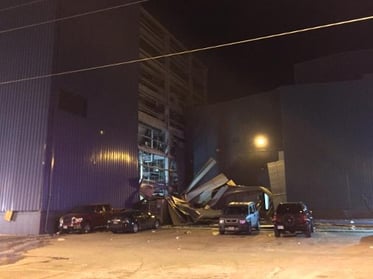
Image Courtesy Of KMBC http://www.kmbc.com/news/3-hurt-in-blast-in-grandview/31730218
Early in the morning of March 11, 2015 an explosion at a flour processing plant in Missouri woke neighbors, who thought a bomb must have gone off. The explosion was caused by a cloud of flour dust coming in contact with an unknown ignition source while overnight workers mixed the flour. Luckily there were no fatalities, but three of the workers were injured.
The flour dust explosion was powerful enough to blow out an entire wall seven stories high, but the resulting fire was quickly brought under control by firefighters. The walls were designed to blow out during an explosion, which helped prevent any serious injuries or deaths, but the machinery inside the building was severely damaged. The company isn’t sure when they will be able to open and begin production again.
According to a report from the Chemical Safety Board, food products account for nearly a quarter of all combustible dust incidents. The only industry that has a higher rate of incidents are those that create wood dust, which shows how important proper housekeeping and dust management procedures are within food processing facilities.
When asked about the explosion, neighbors reported hearing smaller explosions coming from the facility in the past. One neighbor described the other explosions as “Sometimes the windows rattle, but this was the first that was really huge like that.”
This makes it appear that the company or employees knew there was a problem and an explosion risk, and had already experienced several smaller incidents without changing operations or working to improve safety conditions. Unfortunately, we see this situation occurring all the time; where small incidents will occur that should alert someone to the issue, but nothing is done. Then eventually conditions are right for a bigger incident, and people are injured or killed and facilities are damaged. This is also why the exact number of combustible dust incidents each year is not known and is thought to be significantly higher than what is reported. Workers or management do not want to report small explosions or fires if there are no injuries or damage. If these were reported, an OSHA inspector would be called to the site, and the problems would have been found and eliminated before the major incident occurred.

